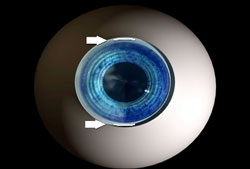Limbal Relaxing Incisions
The outer layer of the eye can be divided into three areas: the cornea, the sclera and the limbus. The cornea is the clear part, or the window, that covers the iris and the pupil. The sclera is the white part of the eye. The limbus is the thin area that connects the cornea and the sclera.
Limbal relaxing incisions (LRIs) treat low to moderate degrees of astigmatism. As the name suggests, the surgeon makes small relaxing incisions in the limbus, which allows the cornea to become more rounded when it heals. LRIs are placed at the very edge of the cornea (in the limbus) on the steepest meridians. LRIs are often combined with other surgical and laser vision correction procedures and cataract surgery.

Limbal Relaxing Incisions are for those:
- who have astigmatism
- want to reduce or eliminate their dependence on glasses or contacts
- have no health issues affecting their eyes
What to expect on surgery day:
You will arrive at the laser center 30-60 minutes prior to your procedure. Once you have been checked in you may be offered a sedative to help you relax. You will then be prepared for surgery. The area around your eyes will be cleaned and a sterile drape may be applied around your eye. Anesthetic eye drops will be used to numb your eyes; no injections or needles will be used. When your eye is completely numb, an eyelid holder will be placed between your eyelids to keep you from blinking during the procedure.
Next, marks will be made on the limbus. These impressions are temporary and used for marking where the surgeon will make the incisions. The marks are based upon a formula taking into account your prescription, age and the amount of correction needed. Next, tiny arc shaped incisions will be made in your limbus. Finally, antibiotic drops will be applied and the eyelid holder will be removed. The actual surgery takes about 5 minutes but with pre-operative preparations, it can take up to an hour.
Following your procedure, you will be given additional eye drops, and your eye may be shielded for protection. Your vision will probably be a little blurry at first, so someone will need to drive you home. You should relax for the rest of the day. You may experience some discomfort, but this is usually alleviated with an over-the-counter pain reliever. Some people experience sensitivity to light, and watering or swelling of their eyes for a few days following the procedure.
Everyone heals differently, but most patients resume normal activities the next day. Some patients see a dramatic improvement in their vision within the first day. For others, vision may be blurry for several weeks.
Realistic expectations:
The decision to have LRIs is an important one that only you can make. The goal of any refractive surgical procedure is to reduce your dependence on corrective lenses. However, we cannot guarantee you will have the results you desire.
Serious complications to LRIs are extremely rare. If you decide that LRIs are an option for you, you will be given additional information about the procedure that will allow you to make an informed decision about whether to proceed. Be sure you have all your questions answered to your satisfaction.
Alternatives to LRIs
LRIs are not the only surgical procedure designed to correct astigmatism. To learn about other procedures go to the vision correction procedures section of our Web Site. If you would like to learn more about vision correction procedures from sources other than our practice, we encourage you to link to a number of Web sites we feel provide factual and up-to-date information. You may also choose to make an appointment or request additional information to learn more.


